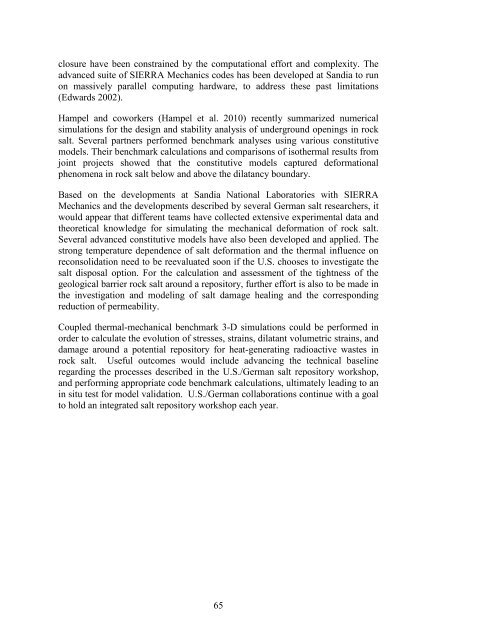Salt Disposal of Heat-Generating Nuclear Waste
Salt Disposal of Heat-Generating Nuclear Waste
Salt Disposal of Heat-Generating Nuclear Waste
You also want an ePaper? Increase the reach of your titles
YUMPU automatically turns print PDFs into web optimized ePapers that Google loves.
closure have been constrained by the computational effort and complexity. The<br />
advanced suite <strong>of</strong> SIERRA Mechanics codes has been developed at Sandia to run<br />
on massively parallel computing hardware, to address these past limitations<br />
(Edwards 2002).<br />
Hampel and coworkers (Hampel et al. 2010) recently summarized numerical<br />
simulations for the design and stability analysis <strong>of</strong> underground openings in rock<br />
salt. Several partners performed benchmark analyses using various constitutive<br />
models. Their benchmark calculations and comparisons <strong>of</strong> isothermal results from<br />
joint projects showed that the constitutive models captured deformational<br />
phenomena in rock salt below and above the dilatancy boundary.<br />
Based on the developments at Sandia National Laboratories with SIERRA<br />
Mechanics and the developments described by several German salt researchers, it<br />
would appear that different teams have collected extensive experimental data and<br />
theoretical knowledge for simulating the mechanical deformation <strong>of</strong> rock salt.<br />
Several advanced constitutive models have also been developed and applied. The<br />
strong temperature dependence <strong>of</strong> salt deformation and the thermal influence on<br />
reconsolidation need to be reevaluated soon if the U.S. chooses to investigate the<br />
salt disposal option. For the calculation and assessment <strong>of</strong> the tightness <strong>of</strong> the<br />
geological barrier rock salt around a repository, further effort is also to be made in<br />
the investigation and modeling <strong>of</strong> salt damage healing and the corresponding<br />
reduction <strong>of</strong> permeability.<br />
Coupled thermal-mechanical benchmark 3-D simulations could be performed in<br />
order to calculate the evolution <strong>of</strong> stresses, strains, dilatant volumetric strains, and<br />
damage around a potential repository for heat-generating radioactive wastes in<br />
rock salt. Useful outcomes would include advancing the technical baseline<br />
regarding the processes described in the U.S./German salt repository workshop,<br />
and performing appropriate code benchmark calculations, ultimately leading to an<br />
in situ test for model validation. U.S./German collaborations continue with a goal<br />
to hold an integrated salt repository workshop each year.<br />
65
















